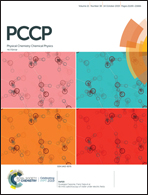Zn-Doped Cu(100) facet with efficient catalytic ability for the CO2 electroreduction to ethylene†
Abstract
Electrochemically converting CO2 into fuels and chemicals is an appealing strategy to create energy rich products. The highly demanded product ethylene has been preferably produced on Cu-based catalysts with abundant exposed Cu(100) facets. However, the performance is still limited by the large energy barrier for the C–C dimerization. Here, to lower the energy barrier, we tailor the electronic structure of Cu(100) by doping a series of transition metals using the density functional theory (DFT) method. The zinc-doped Cu(100) surface has shown a superior catalytic performance. Mechanistic study further reveals that doping with Zn alters the electronic structure around Cu, adjusts the atomic arrangement in the active sites and makes the catalyst surface electronegative, which is conducive to the activation of acidic molecular CO2 and the reduction of the energy barrier for C–C dimerization. This work reveals that the doping of Cu with transition metals has great potential in promoting the electrochemical CO2-to-C2H4 conversion. This work also provides deep insights into the formation mechanisms of C2H4, thus guiding the design of Cu-based bimetallic catalysts for its effective production.



 Please wait while we load your content...
Please wait while we load your content...